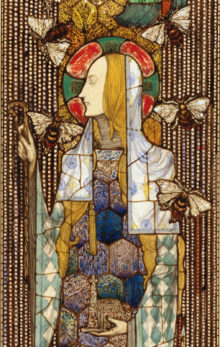- Other Names: Abigail, Deborah, Mo Gobnat, Gobhnet, Gobnaid, Gobnata, Gobnatae
- Feast Day: February 11
- Patron of Honeybees and Beekeepers
Gobnait is Irish for Abigail which means “Brings Joy”. As the patron saint of beekeepers, her name also has been anglicized as Deborah, meaning “Honey Bee.” This Irish saint is a version of the deity Domna, patroness of sacred stones and cairns. The center of her worship was at Ballybourney, Co. Cork, Ireland.
Her feast day, February 11 is called “Pattern Day” in the parishes of Dún Chaoin and in Baile Bhúirne, and is regarded as both holiday and holy day. In one tradition, a medieval wooden carving of Gobnait, about two feet high, kept in a church drawer during the year, is brought out. Parishioners bring a ribbon to ”measure” the statue. This ribbon is then taken home to use when special blessings are needed.
About Saint Gobnait:
Gobnait was born in County Clare in the 5th or 6th Century, and is said to have been the sister of Saint Abban. Tradition holds that Gobnait fled Clare in order to escape family feuding, settling on Inis Oírr (where there is an early medieval oratory, Cill Ghobnait, dedicated to her). Gobnait was said to have been the only woman allowed on the island, but she didn’t linger. After a time, an angel appeared and told her that she was meant to spend the rest of her days (until her soul left her earthly body) elsewhere. She would know the right place because she would find nine white deer grazing there. So she left the island to journey through the southern coastal counties in search of the deer.
As a result of her quest, a number of places now bear her name – for instance, Kilgobnet or Cill Ghobnait in County Kerry and St Debora’s Well in County Limerick. She eventually came upon that mystical herd in Ballyvourney, County Cork, where she dedicated the remainder of her earthly life to pastoral work.
Her connection to honey bees is complex, beginning with the angel telling her to find her “resurrection place” (meaning where the soul leaves the body). Celtic lore held bees in high esteem believing the soul left the body as a bee or a butterfly.
Bees were more than just honey-makers to the ancient Irish. They have long held an important place in Irish culture. The honey, wax, pollen and other benefits of bees were considered so important that in the 7th century, someone scribed the ancient laws called the Bechbretha, which translates to ‘bee-judgements.’ These laws included six different terms in Gaeilge for the kinds of bee swarms, the proper ways to decide ownership of a swarm of bees, how to punish the theft of hives or honey, as well has how much honey a beekeeper should offer their neighbors, and the Caithchi Bech, the trespassing of bees.
Honey is also well-known for its curative properties, and Gobnait was renowned for her care of the sick. Gobnait added beekeeping to her life’s work developing a lifelong affinity with them. She started a religious order and dedicated her days to helping the sick, probably using honey as a healing aid in the treatment of illness and healing of wounds.. St Gobnait had a particular skill in caring for the sick and she is credited with saving the people at Ballyvourney from the plague.
While her focus was on pastoral work such as tending her hives, healing the sick, and founding a religious community for women, Saint Gobnait was not just a placid nun, oh no. Excavations of her home have found that she was also a metal worker, smithing and smelting.
In the ruins of her church there is a smooth round iron ball set into the wall, known as St. Gobnait’s Bowl. It is said to have been used to destroy a fort built by a pagan chief on the hills north of Ballyvourney and was said to have returned to the Saint each time she threw it. Those who have grasped the bowl in the wall will know the miraculous nature of this feat.
There are also legends of her setting swarms of bees on forces attempting to invade Balleyvourney, causing the swollen and stung invaders to return the cattle they stole before they fled. Some accounts go even further, with the bees miraculously changing into soldiers and their hives transformed into bronze helmets.
‘Tháinig na saighdúirí Gallda agus tógadar mórán stuic i mBaile Mhuirne, ach ar an slige dhóibh ag imeacht an bóthar soir do scaoil Naomh Gobnait na beacha as an mbeachaire. Tosnuigeadar ar na saighdúirí a chealg chun nar fágadar súil ná srón ionnta agus b’éigin dóibh an stuic fhágaint ’na ndiadh’.
The English soldiers came and took a lot of stock in Ballyvourney, but on their way out the east road, Saint Gobnait released the bees from the bee-hive. They started to sting the soldiers until they were left without an eye or a nose and they were forced to leave the stuff behind them.
(from The Bee, its Keeper and Produce, in Irish and other Folk Traditions)
Collected from various sources and compiled by Shirley Twofeathers for The Powers That Be, you may repost and share without karmic repercussions, but only if you give me credit and a link back to this website. Blessed be.




Leave a Reply